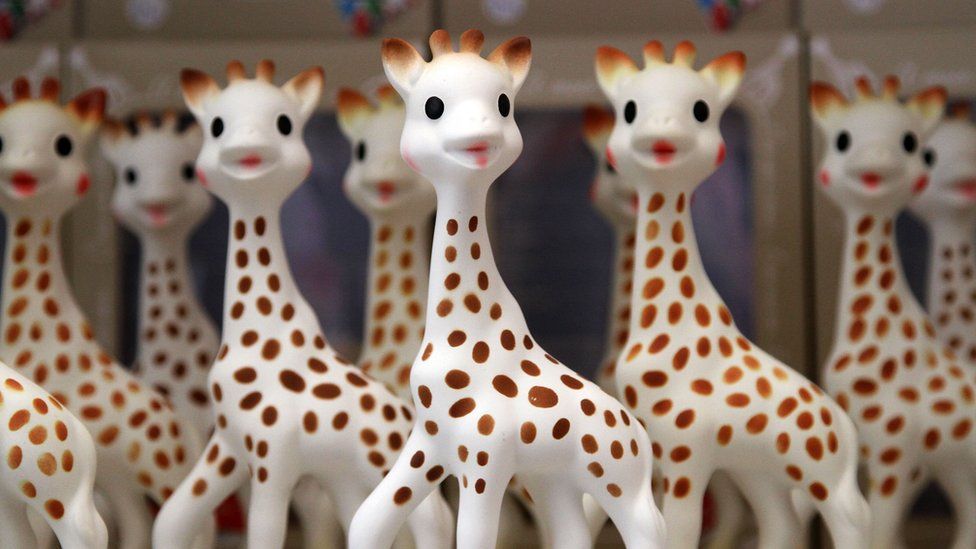Sophie the Giraffe: How safe is it?
- Published

It has been a favourite with children, and parents, for generations. But after mould was found inside the toy by some parents, people online and at home are asking: "Just how safe is my Sophie the Giraffe?"
Who or what is Sophie the Giraffe?
First launched in 1961, it is a squeaky toy giraffe, made from 100% natural rubber. Children seem to enjoy chewing on it, especially when they are teething.
Tens of millions have been sold over the years, and its easy-to-grab shape means that paediatricians, as well as dentists have recommended it.
So, what's the problem?
There have been at least two cases reported of parents finding mould in the toy. And because Sophie is so ubiquitous, the issue has become a real talking point.
Dentist Dana Chianese from New Jersey reported noticing air coming out of a hole in the toy that smelled musty. So she cut it open, only to find "smelly, ugly mould" living in the toy.
And almost a year ago, Stephanie Oprea from the US posted a review on Amazon reporting a similar problem.
"Beware. If you have a drooly baby, moisture will get in the hole and you'll end up with mould. We've had ours for two years and the entire inside is coated with black mould," she wrote.
This week - after her review was picked up by media - she added: "I realise this will not be everyone's experience, but it was mine."
How is the mould getting there?
Sophie has a hole that lets air in and out, and which makes the toy squeezable.
But that also means moisture can get inside. This liquid is usually either the saliva of a child chewing the giraffe, or the result of parents cleaning it.
Mould needs two things to grow - water and warmth - and so over time, mould can grow inside the toy.
Is mould in baby toys dangerous?
Mould spores are in the air that we breathe every day, so most people, babies and adults, can deal with them.
Most doctors agree that while it is not ideal that children are exposed to mould, most moulds are fairly harmless unless the child has an extremely susceptible immune system.
Dr Richard Loh, a consultant immunologist at the Princess Margaret Hospital in Perth, Western Australia said that in his more than 20 years in the field, he was not aware of any research linking mould on toys to health concerns.
"Mould is all around us. If your child is in the park, picking up leaves and bits of grass, licking them and chewing them, there'll be mould there. We encounter mould a lot and in general we do not get ill.
"Would I knowingly give a child a toy with mould on it? Of course not. But if I discovered it afterwards, there'd be no need to be horrified or worried."
Dr Loh added there were extremely rare cases where people were allergic to mould. And he stressed severely mouldy environments, such as rooms left damp after flooding, could pose a health risk.
What is the company saying?
Sophie the Giraffe is made by French firm Vuilli, (which incidentally calls it Sophie la Girafe).
Vuilli said it had not been sent the mouldy toys for inspection, but that complaints were taken seriously and that children's safety, along with parental satisfaction, were its main priorities.
It also said there were clear instructions on how to clean the toy correctly - including wiping with a damp cloth rather than immersing it in water and not putting it in the microwave or steam steriliser.
Surely this is not just about giraffes?
It seems not.
"If you take any bath toy that has been in the water and played with for a long time, then you cut it open, there's a good chance you'll find mould," Dr Loh said.
And so while the giraffe seems to be at the heart of this particular story, things like rubber ducks are also susceptible.